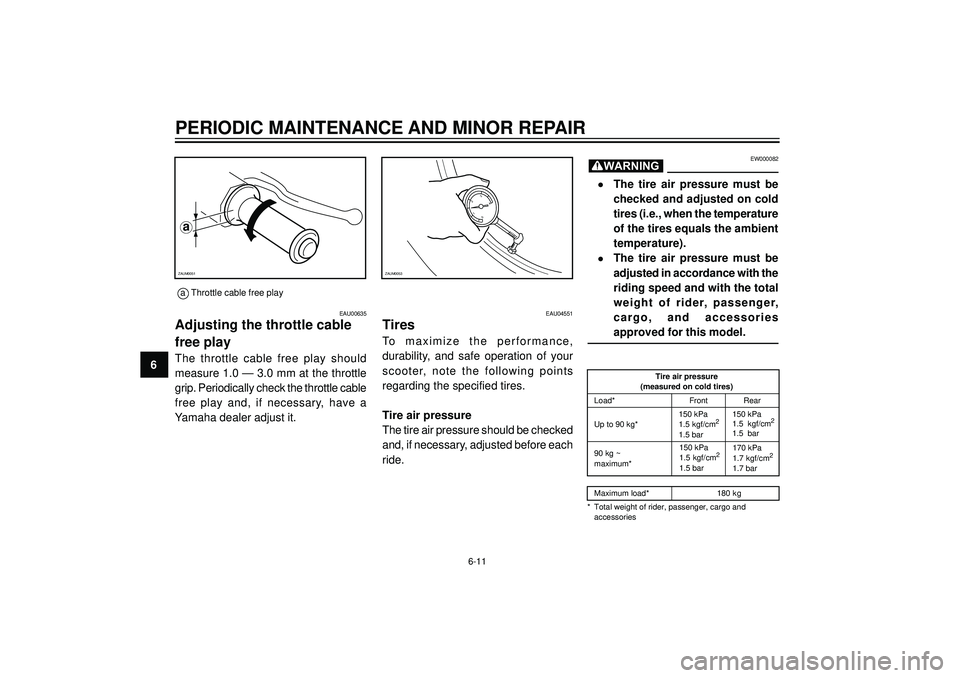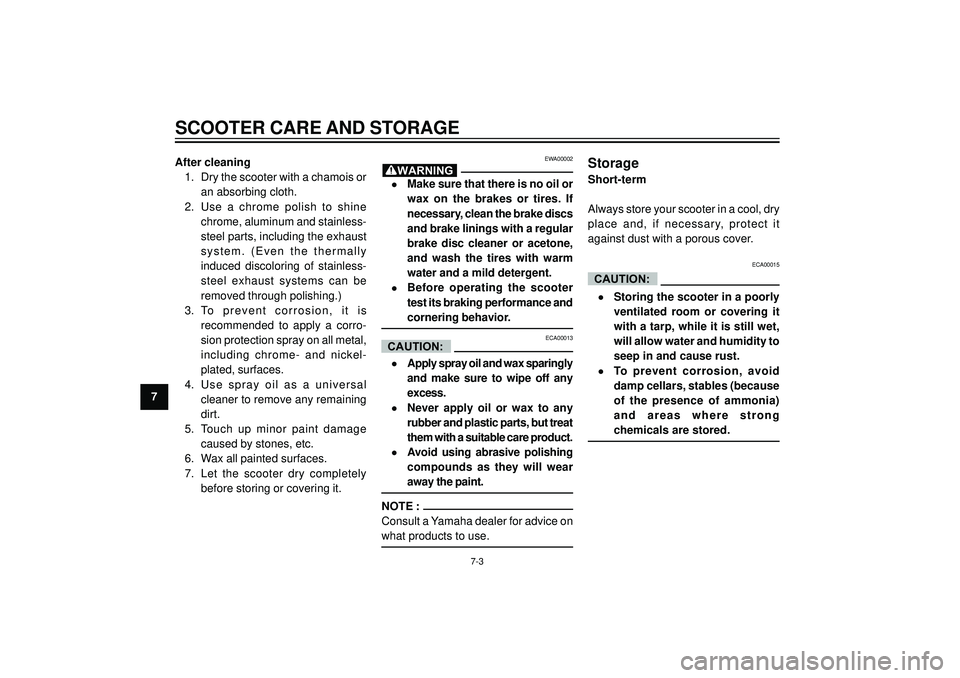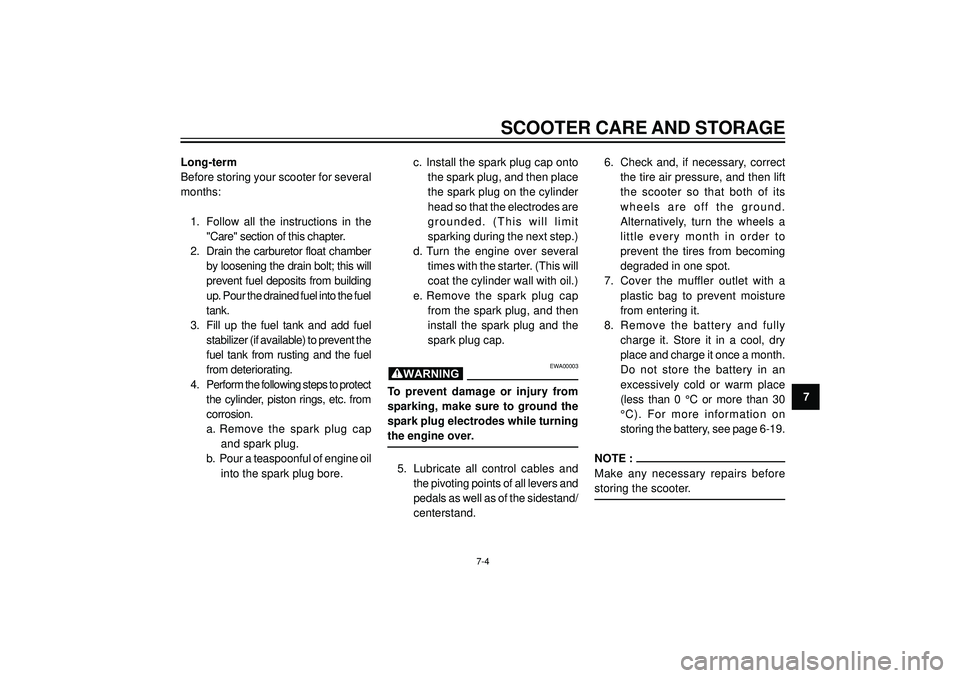2004 YAMAHA AEROX50 tires
[x] Cancel search: tiresPage 34 of 84

4
PRE-OPERATION CHECKS
ITEM CHECKS PAGE
• Make sure that operation is smooth.
Throttle grip• Check cable free play.
6-11
• If necessary, have Yamaha dealer adjust cable free play
and lubricate cable and grip housing.
• Check for damage.
Wheels and tires• Check tire condition and tread depth.
6-11 — 6-13
• Check air pressure.
• Correct if necessary.
Brake levers• Make sure that operation is smooth.
6-13, 6-16
• Lubricate lever pivoting points if necessary.
Centerstand• Make sure that operation is smooth.
6-16
• Lubricate pivot if necessary.
Chassis fasteners• Make sure that all nuts, bolts and screws are properly tightened.
—
• Tighten if necessary.
Instruments, lights• Check operation.
3-3, 3-4, 6-20 — 6-22
signals and switches• Correct if necessary.
Battery• Check fluid level.
6-18
• Fill with distilled water if necessary.
4-2
Page 42 of 84

EAU00462
PERIODIC MAINTENANCE AND MINOR REPAIR
Periodic maintenance and lubrication chart ............ 6-2
Removing and installing cowling and panel ............ 6-5
Cowling A ................................................................ 6-5
Panel A .................................................................... 6-5
Checking the spark plug ......................................... 6-6
Final transmission oil .............................................. 6-7
Coolant .................................................................... 6-8
Cleaning the air filter element ................................. 6-9
Adjusting the carburetor ........................................ 6-10
Adjusting the throttle cable free play ..................... 6-11
Tires ...................................................................... 6-11
Wheels .................................................................. 6-13
Adjusting the front and rear brake lever
free play ................................................................ 6-13
Checking the front and rear brake pads ................ 6-14
Checking the brake fluid level ............................... 6-14
6 Changing the brake fluid ....................................... 6-15
Adjusting the autolube pump ................................ 6-15
Checking and lubricating the cables ..................... 6-16
Lubricating the front and rear brakes levers .......... 6-16
Checking and lubricating the centerstand ............. 6-16
Checking the front fork .......................................... 6-17
Checking the steering ........................................... 6-17
Checking the wheel bearings ................................ 6-18
Battery ................................................................... 6-18
Replacing the fuse ................................................ 6-20
Replacing a headlight bulb .................................... 6-20
Replacing tail/brake light bulb ............................... 6-21
Replacing a turn signal light bulb .......................... 6-22
Troubleshooting ..................................................... 6-22
Troubleshooting chart ............................................ 6-23
Engine overheating ............................................... 6-24
Page 45 of 84

PERIODIC MAINTENANCE AND MINOR REPAIR
6
• Check tread depth and for damage.
9 * Tires• Replace if necessary.
√√√√ √
• Check air pressure.
• Correct if necessary.
10 * Wheel bearings• Check bearing for looseness or damage.√√√√
11 * Steering bearings• Check bearing play and steering for roughness.√√√√√• Lubricate with lithium-soap-based grease. Every 24,000 km
12 * Chassis fasteners• Make sure that all nuts, bolts and screws are
√√√√ √
properly tightened.
13 Centerstand• Check operation.
√√√√ √
• Lubricate.
14 * Front fork• Check operation and for oil leakage.√√√√
15 * Shock absorber assembly• Check operation and shock absorber for oil leakage.√√√√
16 * Carburetor• Check starter (chocke) operation.
√√√√√ √
• Adjust engine idling speed.
17 * Autolube pump• Check operation.
√√√√
• Bleed if necessary.
18 Final transmission oil• Check vehicle for oil leakage.√√ √• Change.√√√
19 * V-belt• Replace. Every 10,000 km
20 * Front and rear brake
• Check operation.√√√√√ √
switches
ODOMETER READING (x 1,000 km)
NO. ITEMCHECK OR MAINTENANCE JOB
1
ANNUAL
CHECK
6121824
6-3
Page 53 of 84

PERIODIC MAINTENANCE AND MINOR REPAIR
6
EAU04551
Tires
To maximize the performance,
durability, and safe operation of your
scooter, note the following points
regarding the specified tires.
Tire air pressure
The tire air pressure should be checked
and, if necessary, adjusted before each
ride.
EW000082
•The tire air pressure must be
checked and adjusted on cold
tires (i.e., when the temperature
of the tires equals the ambient
temperature).
•The tire air pressure must be
adjusted in accordance with the
riding speed and with the total
weight of rider, passenger,
cargo, and accessories
approved for this model.
WARNING
0 12
3
4
ZAUM0053
Tire air pressure
(measured on cold tires)
Load* Front Rear
Up to 90 kg*150 kPa
1.5 kgf/cm
2
1.5 bar150 kPa
1.5 kgf/cm
2
1.5 bar
90 kg ~
maximum*
150 kPa
1.5 kgf/cm2
1.5 bar170 kPa
1.7 kgf/cm
2
1.7 bar
Maximum load* 180 kg
* Total weight of rider, passenger, cargo and
accessories
6-11
a
ZAUM0051
EAU00635
Adjusting the throttle cable
free play
The throttle cable free play should
measure 1.0 — 3.0 mm at the throttle
grip. Periodically check the throttle cable
free play and, if necessary, have a
Yamaha dealer adjust it.
a Throttle cable free play
Page 54 of 84

PERIODIC MAINTENANCE AND MINOR REPAIR
6 Tire inspection
The tires must be checked before each
ride. If the center tread depth reaches
the specified limit, if the tire has a nail
or glass fragments in it, or if the sidewall
is cracked, have a Yamaha dealer re-
place the tire immediately.
1
2
ZAUM0054
1. Tread depth
2. Side wall
Tire information
This scooter is equipped with tubeless
tires.
Minimum tire tread depth
(front and rear)1.6 mm
NOTE :
The tire tread depth limits may differ
from country to country. Always comply
with the local regulations.
Front
Manufacturer Size Type
PIRELLIM 130/60-13M SL36
Rear
Manufacturer Size Type
MICHELINM 130/60-13M BOPPER
PIRELLIM 130/60-13M EVO 21
PIRELLIM 140/60-13M SL36
MICHELINM 140/60-13M BOPPER
PIRELLIM 140/60-13 M EVO 22
6-12
EW000077
Because loading has an enormous
impact on the handling, braking, per-
formance and safety characteristics of
your scooter, you should keep the
following precautions in mind.
•NEVER OVERLOAD THE SCOO-
TER! Operation of an overloaded
scooter may result in tire damage,
loss of control, or severe injury.
Make sure that the total weight of
rider, cargo, and accessories
does not exceed the specified
maximum load for the vehicle.
•Do not carry along loosely
packed items, which can shift
during a ride.
•Securely pack the heaviest items
close to the center of the scooter
and distribute the weight evenly
on both sides.
•Adjust the suspension and tire air
pressure with regard to the load.
•Check the tire condition and air
pressure before each ride.
WARNING
Page 71 of 84

SCOOTER CARE AND STORAGE
7After cleaning
1. Dry the scooter with a chamois or
an absorbing cloth.
2. Use a chrome polish to shine
chrome, aluminum and stainless-
steel parts, including the exhaust
system. (Even the thermally
induced discoloring of stainless-
steel exhaust systems can be
removed through polishing.)
3. To prevent corrosion, it is
recommended to apply a corro-
sion protection spray on all metal,
including chrome- and nickel-
plated, surfaces.
4. Use spray oil as a universal
cleaner to remove any remaining
dirt.
5. Touch up minor paint damage
caused by stones, etc.
6. Wax all painted surfaces.
7. Let the scooter dry completely
before storing or covering it.
EWA00002
•Make sure that there is no oil or
wax on the brakes or tires. If
necessary, clean the brake discs
and brake linings with a regular
brake disc cleaner or acetone,
and wash the tires with warm
water and a mild detergent.
•Before operating the scooter
test its braking performance and
cornering behavior.
ECA00013
•Apply spray oil and wax sparingly
and make sure to wipe off any
excess.
•Never apply oil or wax to any
rubber and plastic parts, but treat
them with a suitable care product.
•Avoid using abrasive polishing
compounds as they will wear
away the paint.
NOTE :
Consult a Yamaha dealer for advice on
what products to use.
Storage
Short-term
Always store your scooter in a cool, dry
place and, if necessary, protect it
against dust with a porous cover.
ECA00015
•Storing the scooter in a poorly
ventilated room or covering it
with a tarp, while it is still wet,
will allow water and humidity to
seep in and cause rust.
•To prevent corrosion, avoid
damp cellars, stables (because
of the presence of ammonia)
and areas where strong
chemicals are stored.
WARNING
CAUTION:
CAUTION:
7-3
Page 72 of 84

SCOOTER CARE AND STORAGE
7 Long-term
Before storing your scooter for several
months:
1. Follow all the instructions in the
"Care" section of this chapter.
2. Drain the carburetor float chamber
by loosening the drain bolt; this will
prevent fuel deposits from building
up. Pour the drained fuel into the fuel
tank.
3. Fill up the fuel tank and add fuel
stabilizer (if available) to prevent the
fuel tank from rusting and the fuel
from deteriorating.
4. Perform the following steps to protect
the cylinder, piston rings, etc. from
corrosion.
a. Remove the spark plug cap
and spark plug.
b. Pour a teaspoonful of engine oil
into the spark plug bore.c. Install the spark plug cap onto
the spark plug, and then place
the spark plug on the cylinder
head so that the electrodes are
grounded. (This will limit
sparking during the next step.)
d. Turn the engine over several
times with the starter. (This will
coat the cylinder wall with oil.)
e. Remove the spark plug cap
from the spark plug, and then
install the spark plug and the
spark plug cap.
EWA00003
To prevent damage or injury from
sparking, make sure to ground the
spark plug electrodes while turning
the engine over.
5. Lubricate all control cables and
the pivoting points of all levers and
pedals as well as of the sidestand/
centerstand.6. Check and, if necessary, correct
the tire air pressure, and then lift
the scooter so that both of its
wheels are off the ground.
Alternatively, turn the wheels a
little every month in order to
prevent the tires from becoming
degraded in one spot.
7. Cover the muffler outlet with a
plastic bag to prevent moisture
from entering it.
8. Remove the battery and fully
charge it. Store it in a cool, dry
place and charge it once a month.
Do not store the battery in an
excessively cold or warm place
(less than 0 °C or more than 30
°C). For more information on
storing the battery, see page 6-19.
NOTE :
Make any necessary repairs before
storing the scooter.
WARNING
7-4
Page 76 of 84

SPECIFICATIONS
8
Chassis:
Frame type Steel tube underbone
Caster angle 27°
Trail 89.4 mm
Tires:
Front:
Type Tubeless
Size 130/60-13 53L TL
Manufacturer/ Model PIRELLI / SL36
PIRELLI / EVO 21
MICHELIN / BOPPER
Rear:
Type Tubeless
Size 140/60-13 57L TL
anufacturer/ Model PIRELLI / SL36
PIRELLI / EVO 22
MICHELIN / BOPPER
Maximum load* 180 kg
Tir air pressure
(mesured on cold tires):
Up to 90 kg
Front150 kpa
Rear 150 kpa
90kg—maximum*
Front150 kpa
Rear 170 kpa
* Total weight of rider, passenger, cargo and accessoriesWheels:
Front
Type Cast wheel
Size 13 X MT 3.00
Rear
Type Cast wheel
Size 13 X MT 3.50
Brakes:
Front
Type Single disc brake
Operation Right hand operation
Type brake fluid DOT 3 or DOT 4
Rear
Type Single disc brake
Operation Left hand operation
Type brake fluid DOT 3 or DOT 4
Suspension:
Front suspension Telescopic fork
Rear suspension Unit swing
Shock absorber:
Front fork type Coil spring/oil damper
Rear shock absorber Coil spring/oil damper
assembly type or Coil spring/Gas-oil damper
(Depends on model)
Wheel travel:
Front wheel travel 80 mm
Rear wheel travel 72 mm
8-2